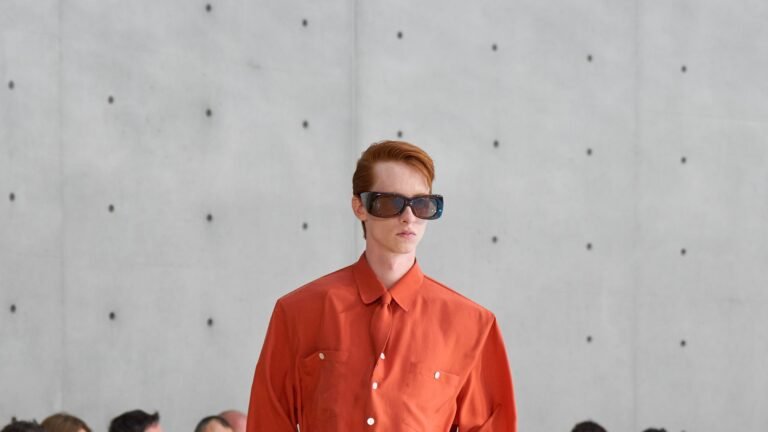Dark brown short-shorts with turn-ups, cut almost in the manner of pleated city trousers. A ledge-shouldered burnt orange washed silk shirt with a matching tie, twisted and tucked in at precisely the third button down. A greenish-yellow slouchy satin suit, sleeves pushed up, hands nonchalantly thrust in pockets, with a matching shirt. And again, that very specific twist-and-tuck of the tie.
What a great colorist Antony Vaccarello can be—and how precisely and single-mindedly he stamps a silhouette and an attitude on a collection. He exerted both those talents on this spring menswear collection. “I didn’t want to be stuck in that kind of darkness,” he said at a preview. It was a surprise, all right. Vaccarello is more normally at home pushing the dramatic, powerful kinky-chic Parisian codes of Saint Laurent; the thigh-high leather boots he put on top of business suits last season had fashion fans raving.
But this time, he had a chromatic treat in store—an extended tonal essay in burgundy, ochre, yellow, eau de nil, navy, cerulean blue, and an unnameable spectrum of browns. In almost every look, the torque of that tie— sometimes matching the shirt, sometimes sharply clashing with it—played its part. I don’t think there was a single black piece (except the uniform lace-up shoes) on the runway.
Added to the repetition of shapes—the drapey, gathered-waist trousers, the padded-shoulder shirts, the flowy yet crisp trench coats—the whole effect became quite mesmerizing. Yet, trust Vaccarello: these choices had another set of Saint Laurent meanings embedded in them. “It was a combination of Saint Laurent in 1974, and Fire Island in the ’80s.”
Yves Saint Laurent never went to Fire Island, but Vaccarello was thinking more about “all those amazing moments he had with friends in Morocco and Paris. It was a weird period of time for him. He withdrew, and I kind of related that to the chaos the world is in now.”
A photo of the young, long-legged Yves playing tennis (on holiday in Nigeria, as it happens) wearing wide, cuffed shorts and a long-sleeve camp shirt of some sort triggered the first look out, and indeed it can be read into the padded-shoulder shirt silhouette that is the main architecture of the collection. “It’s like the women’s collection,” he added. “You can button out the pads. And then, it’s a soft, slouchy shape.”
The Fire Island connection—another part of queer history—came to him when he was recently shown a film (not yet released) about the late artist Larry Stanton. The collection also became a kind of tribute to fellow artists Patrick Angus and Billy Sullivan as well as to the generation of beautiful young men who lost their lives to AIDS in those years. The vibrant colors in the artists’ portraits leapt directly to Vaccarello’s palette.
Why did he choose that inspiration, someone asked him backstage. “Because I’m gay,” Vaccarello replied. But also, he added: “Because they lived an intense and fun time, not knowing what was going to happen. I related that to what is happening today in general. Maybe we should be thinking more. To be sure not to miss your life.”


